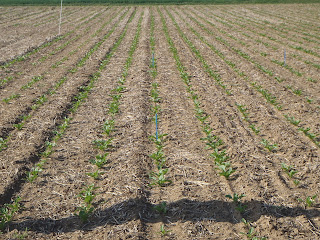Nathan Morris of NIAB TAG and I recently went to Southern Germany to a strip tillage conference with two objectives. Firstly to see if they knew something we didn’t, and secondly to develop relationships so we can work collaboratively in the future. The event was organised by the University of Hohenheim and based at their research farm Ihinger Hof. I was particularly interested in the farm as it is very similar to the farm here at Morley, with a range of plot trials and larger cultivation work. They even have a grass weed trial were blackgrass is encouraged. It sounds as though the farm manager also pulls his hair out. Strip tillage is where a narrow band is cultivated about 200mm wide, then seeds are sown in a row at the same time or later. Needless to say, this technique is only suited to crops that can be sown in wide rows e.g. maize 75cm, sugar beet 50cm, oilseed rape 50cm, beans etc. The land in between the rows is left untouched.
The first afternoon of the conference (following some ham and noodle soup/water) started with presentations from Michael Horsch. Although the visual part of the presentation was good and we got the gist of what he was trying to promote, unfortunately the only spoken words of German I know are Volkswagen and Claas.
The second day started with a tour of the trials involving strip tillage followed by demonstrations of 7 different machines working in a field. Before the morning started, we asked the organisers if anyone could help with the translation. Veit Nubel was assigned the task. Veit is a fieldsman for Sudzucker, the equivalent of British Sugar, but more to the point good at translating German to English. Once other delegates realised that we were English they all come over to us and wanted to talk about our English ways, particularly how to establish oilseed rape behind a subsoiler.
 |
| Ihinger hof sugar beet mid May waiting for rain |
The sugar beet established using a strip tillage approach suffered from the same problems as the crop at Morley, some rows very good and some poor due to crop residue, previous crop wheel marks and poor seed to soil contact a particular problem with the absence of rain. The establishment ranged from 75-80% with strip tillage but 90-95% with the conventional mulch tillage (a chisel plough to 20cm). Very similar establishment to the 2011 strip tillage trial at Morley.
 |
| OSR establishment trial not the X factor |
The demonstrations of the machines were very interesting as it gave time for delegates to chat and pass opinion. It was clear to see which worked best on the chosen field, but we don’t all farm on a silty clay loam in southern Germany but interesting none the less. Nathan Morris has been using a Yetter machine for 6 years with variable degrees of success but without the reliability to commit to whole fields. Some of the machines showed the potential for coping in a wide range of soil conditions. I also think we need a better drill that can cope with a more variable seedbed.
For more information about the event uni-hohenheim
For more information about the event uni-hohenheim